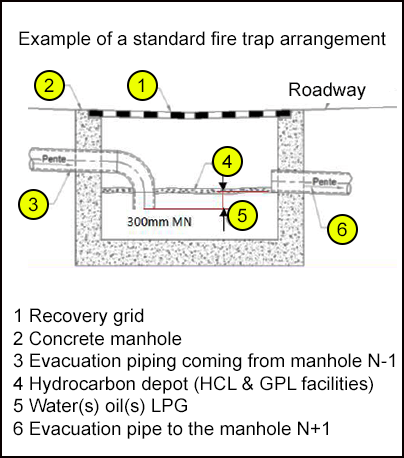-
What happened?
A hot work permit was issued for cutting gudgeons on the platform of a filling building, so that a new working carpet could be installed.
A rubber carpet was being used as a protective measure during cutting.
The supervisor was called away for 5 minutes.
During his absence, the operator moved to cut a gudgeon, without repositioning the protective rubber carpet.
An incandescent particle reached a rainwater drain 5m/16ft away, which contained stagnant gas.
Inflammation occurred and propagated in the rainwater sewer network. Fire erupted simultaneously from 4 drains, 2m/6.5ft high.
The fire was extinguished 2 minutes later using powder fire extinguishers. The gas trapped in the sewer network was later expelled by introduction of water.

-
Why did it happen?
Liquid petroleum gas (LPG) gases in concentrations between 2% and 10% form explosive mixtures.
As LPG gases are heavier than air they will collect in low points, especially in sewers, where they can form a large explosive gas volume.
The rainwater sewers were 60 cm deep. A great quantity of gas had accumulated in them.
There was no means to prevent the free flow of gas inside the rainwater network.
The cutting operation was not in the original plan. It was being carried out to adjust the fit of the working carpet.
A new work permit was not obtained once the conditions changed.

-
What did they learn?
To prevent the risk of gas invasion and the collection of large volumes of explosive mixtures in uncontrolled areas, sewers located in areas with a risk of LPG leakage must be equipped with fire traps.
Analyse the risks before starting works and implement the necessary controls – e.g. is there adequate means of protection against incandescent projections?
Establish a new work permit if the conditions change or if the procedure is modified.
Do not stop supervising work, even if temporarily.

-
Ask yourself or your crew
How can something like this happen here?
What measures do we have in place for today’s task that protect against incandescent projections?
Look around you. Can you spot any locations where escaped gas may be trapped and could ignite during today’s job?
How can we improve our hot work procedures to prevent incidents?
What else can we learn from this incident?

Add to homescreen
Content name
Select existing category:
Content name
New collection
Edit collection
What happened?
A hot work permit was issued for cutting gudgeons on the platform of a filling building, so that a new working carpet could be installed.
A rubber carpet was being used as a protective measure during cutting.
The supervisor was called away for 5 minutes.
During his absence, the operator moved to cut a gudgeon, without repositioning the protective rubber carpet.
An incandescent particle reached a rainwater drain 5m/16ft away, which contained stagnant gas.
Inflammation occurred and propagated in the rainwater sewer network. Fire erupted simultaneously from 4 drains, 2m/6.5ft high.
The fire was extinguished 2 minutes later using powder fire extinguishers. The gas trapped in the sewer network was later expelled by introduction of water.
Why did it happen?
Liquid petroleum gas (LPG) gases in concentrations between 2% and 10% form explosive mixtures.
As LPG gases are heavier than air they will collect in low points, especially in sewers, where they can form a large explosive gas volume.
The rainwater sewers were 60 cm deep. A great quantity of gas had accumulated in them.
There was no means to prevent the free flow of gas inside the rainwater network.
The cutting operation was not in the original plan. It was being carried out to adjust the fit of the working carpet.
A new work permit was not obtained once the conditions changed.
What did they learn?
To prevent the risk of gas invasion and the collection of large volumes of explosive mixtures in uncontrolled areas, sewers located in areas with a risk of LPG leakage must be equipped with fire traps.
Analyse the risks before starting works and implement the necessary controls – e.g. is there adequate means of protection against incandescent projections?
Establish a new work permit if the conditions change or if the procedure is modified.
Do not stop supervising work, even if temporarily.

Ask yourself or your crew
How can something like this happen here?
What measures do we have in place for today’s task that protect against incandescent projections?
Look around you. Can you spot any locations where escaped gas may be trapped and could ignite during today’s job?
How can we improve our hot work procedures to prevent incidents?
What else can we learn from this incident?
An incandescent particle reached a rainwater sewer drain filled with stagnant LPG. Inflammation occurred and propagated in the rainwater sewer network. Fire erupted simultaneously from 4 drains, 2m/6.5ft high. It was extinguished 2 minutes later using powder fire extinguishers.












